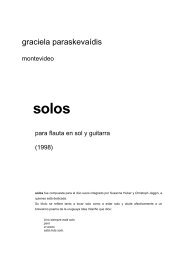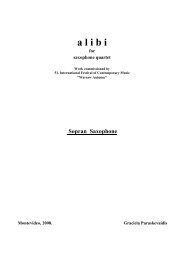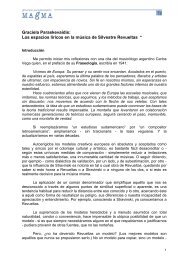El musicólogo alemán Hanns-Werner Heister - GP-Magma
El musicólogo alemán Hanns-Werner Heister - GP-Magma
El musicólogo alemán Hanns-Werner Heister - GP-Magma
You also want an ePaper? Increase the reach of your titles
YUMPU automatically turns print PDFs into web optimized ePapers that Google loves.
‘natural’ a la impronta fascista, sobre todo a la militar e imperialista, la<br />
extremadamente nacionalista, racista y autoritaria. 26<br />
Varios ejemplos musicales de la época demuestran que - previsiblemente -, la<br />
fascistización ideológica incide - directa o indirectamente - sobre los elementos<br />
estéticos y técnicos y sus resultados. Baste aquí mencionar a Carl Orff o, en otros<br />
ámbitos creativos, a la cineasta Leni Riefenstahl y al arquitecto Albert Speer.<br />
Por último, <strong>Heister</strong> deja claro cuál fue el antecedente que propició el papel<br />
protagónico de la música en el Tercer Reich:<br />
“La convocatoria de la ‘música alemana’ a dominar el mundo ya había sido<br />
inventada, con fundamentos chovinistas o raciales y con las correspondientes<br />
motivaciones, por los conservadores alemanes antes que por los nazis.” 27<br />
Anexo: Otros escritos de <strong>Hanns</strong>-<strong>Werner</strong> <strong>Heister</strong><br />
- “Extern and Internal Incentives. Approach to the Logic of Innovation in the History of Music”, ponencia<br />
para el congreso Music and Lifeworld: Otherness and Transgression in the Culture of 20th Century. In<br />
Memoriam Fernando Lopes-Graça, 14-17 de diciembre de 1996. Cascais/Portugal, en prensa.<br />
- H.-W. <strong>Heister</strong> (textos y materiales) e I. Gellrich (fotografías), Un/Endlichkeiten. Begegnungen mit<br />
György Ligeti 1989-2003. Freiburg i. Br., Modo, 2008.<br />
- „Geschlechterverhältnisse als Modell. Musik-Anthropologie: Gegenstände, Themen, Forschungsperspektiven”,<br />
en Musik – nicht ohne Worte. Beiträge zu aktuellen Fragen aus Komposition, Musiktheorie<br />
und Musikwissenschaft (M. Stahnke, comp., Hamburg, 2000), pp. 13-46.<br />
- “Natura, spirito, società. Antropologia musicale e nuova musicologia”, Musica/Realtà 22/65 (2001), pp.<br />
25-54 (Parte I); 66, pp. 115-150 (Parte II).<br />
- „Singen, Klingen, Sagen. Zur Komplementarität von Vokalem und Instrumentalem”, Kunstwerk und<br />
Biographie. Gedenkschrift Harry Goldschmidt. (Zwischen/Töne 1, H.-W. <strong>Heister</strong> comp., Berlin, 2002), pp.<br />
121-155.<br />
- „Zur Theorie der Virtuosität. Eine Skizze”, Musikalische Virtuosität. (Klang und Begriff 1. H. von Loesch,<br />
U. Mahlert y P. Rummenhöller, comp. Mainz, 2004), pp. 17-38.<br />
- „Gegen die Ökonomisierung der Lebenswelt. Über Kreativität als künstlerische Produktivität, individuelle<br />
und soziale Selbstverwirklichung”, Musik Forum III-2005, X-XII 2005, pp. 15-18.<br />
- „Mimetische Zeremonie – Gesamtkunstwerk und alle Sinne. Aspekte eines Konzepts”, Mimetische<br />
Zeremonien – Musik als Spiel, Ritual, Kunst (Musik und 7, Berlin, 2007), pp. 143-185.<br />
26 Kühnl, p. 53.<br />
27 <strong>Heister</strong>, op. cit., p. 309.<br />
12



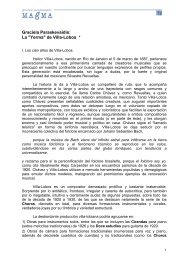
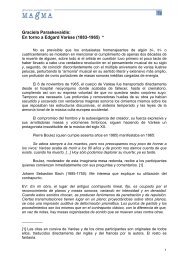
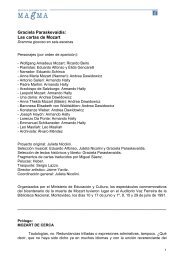
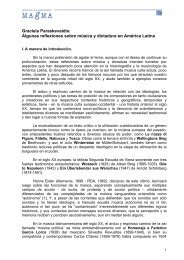

![Finale 2008 - [ALIBI GRACIELA31 05 1158f2008.MUS] - GP-Magma](https://img.yumpu.com/42243018/1/190x134/finale-2008-alibi-graciela31-05-1158f2008mus-gp-magma.jpg?quality=85)

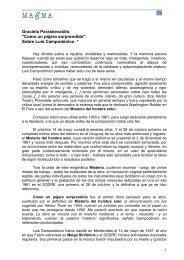

![SENDAS -PARASKEVAIDIS-PARTITURA [2].pdf - GP-Magma](https://img.yumpu.com/31551603/1/184x260/sendas-paraskevaidis-partitura-2pdf-gp-magma.jpg?quality=85)

